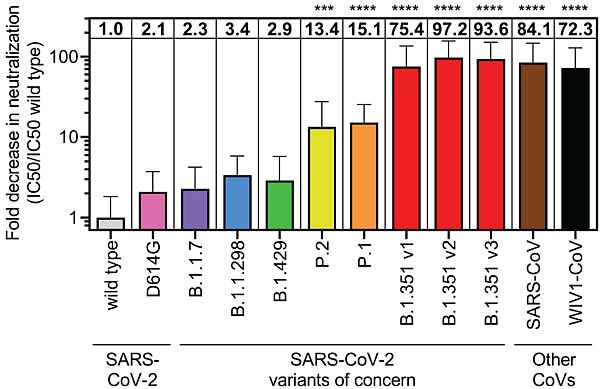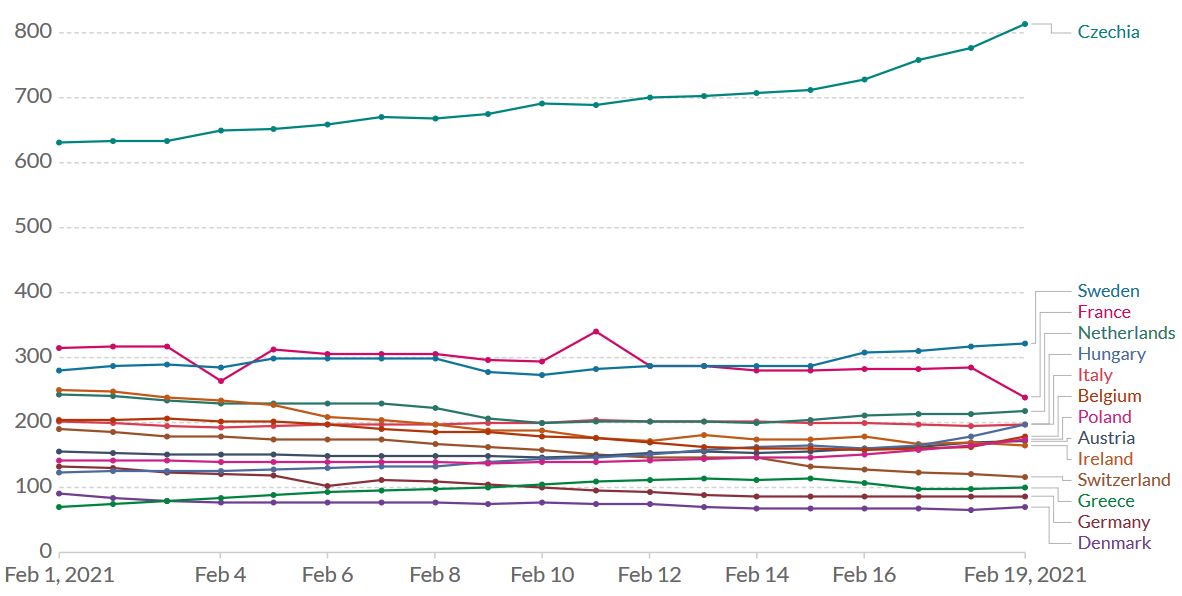<<< Chapter Variants
B.1.1.7 in Europe
The more transmissible “English” variant B.1.1.7 will soon become the dominant strain in almost all countries of continental Europe. The current ‘flat pandemigram’ in most European countries might be deceiving – it could be the calm before the storm, most countries simply being in the middle of “two different epidemics: a small epidemic that is growing rapidly with the new variant, and a large epidemic of the original virus on the decline” (Kucharski, cited by Dagorn 2021).
Figure 1. Flat ‘pandemigram’ in Europe in February 2021. The calm before the storm?
In some places, for example in the urban community of Dunkirk, France, just vis-à-vis of Kent, England, the cumulative 7-day incidence rate per 100.000 people reached 713 on 19 February. The share of the B.1.1.7 variant was estimated at 72% of cases and hospitals were seeing a large influx of patients (Stromboni 2021). Although ‘hard’ lockdowns are apt at controlling the new variants (see below: UK, Ireland, South Africa), the coming weeks may display very different scenarios in different countries (Figure 2).
Infection with B.1.1.7 is likely to be associated with an increased risk of hospitalization and death compared to infection with previsously circulating viruses (NERVTAG 20210211).

Figure 2. March to May 2021: possible scenarios for national epidemics. Blue: new SARS-CoV-2 infections due to old variants; red: new SARS-CoV-2 infections due to new variants. On the left, mitigation measures succeed in keeping case numbers low until the general availability of vaccines for the adult population. On the left, an uncontrolled epidemic is fuelled by the higher transmissibility of the new SARS-CoV-2 variants. Graphic copyright: Süddeutsche Zeitung, 5 February (Berndt 2021).
B.1.1.7 and vaccines
The good news for B.1.1.7 is that current vaccines seem to retain efficacy against the variant. In Israel, the Pfizer-BioNTech vaccine has been shown to descrease the number of hospitalizations and deaths in vaccinated invidivuals (Amit 2021). In vivo data confirm that strains like B.1.1.7, B.1.1.298, or B.1.429, continue to be potently neutralized by sera from vaccine recipients (Garcia-Beltran 2021).
B.1.351
With regard to vaccine efficacy, the major concern is currently B.1.351 (first detected in South Africa) and, to a minor extent, P.1 and P.2 (Brazil). The ChAdOx1-nCoV19 vaccine (AstraZeneca) did not show protection against mild-moderate Covid-19 due to B.1.351 (Madhi 2021). These findings were reproduced in an in vitro study which showed that B.1.351 variants escaped neutralizing vaccine responses like SARS-CoV-1 (!!; SARS 2002/2003) and bat-derived WIV1-CoV (Garcia-Beltran 2021). A relatively small number of mutations can therefore mediate potent escape from vaccine responses (Figure 3).

Figure 3. Fold decrease in neutralization for each pseudovirus relative to wild type for 22 vaccine recipients >7 days after the second dose of the Pfizer-BioNTech vaccine. Source and copyright: Garcia-Beltran et al.
In the coming months, understanding innate (Schultze & Aschenbrenner 2021) and adapte immune responses (Sette & Crotty 2021) will be helpful.

